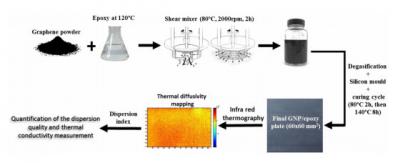University of Manchester researchers, from the i-composite lab, have devised a method to characterize the dispersion of nanoparticles in polymer nanocomposites using non-contact infrared thermography mapping that measures the thermal diffusivity (α) of the graphene nanocomposite and relates α to a dispersion index.

The main advantage of the proposed method is its ability to evaluate dispersion over a large area at reduced effort and cost, in addition to measuring the thermal properties of the system. The actual resolution of this thermal mapping reaches 200μm per pixel, giving an accurate picture of graphene nanoplatelets (GNP) dispersion.
The infrared thermography diffusivity measurement and mapping method has reportedly been validated to be a reliable, easy and low cost technique to characterize the quality of graphene nanoplatelets dispersion at macroscale for relatively large samples. The actual resolution of this technique reaches 200 μm and can be easily improved by using high magnification lens, opening a way to characterize nanocomposite at the microscale.
Unlike other dispersion quality quantification and thermal diffusivity mapping techniques, IR thermography is unique in its ability to map large scale samples in an efficient and less cumbersome way.